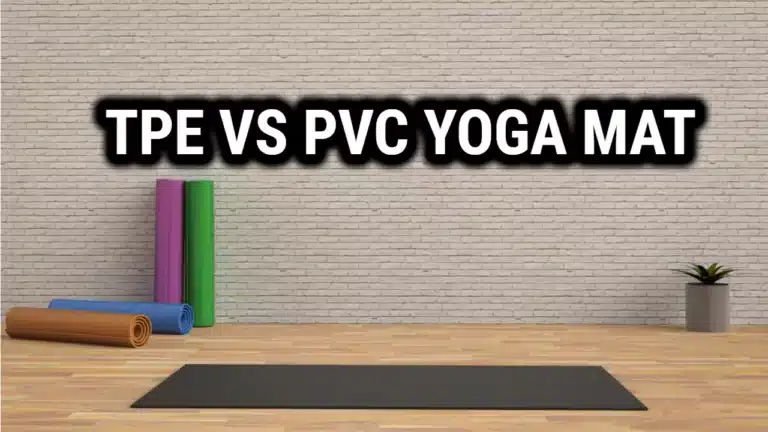Cork Yoga Mat Pros and Cons: A Comprehensive Guide

Yoga is a practice that requires focus, balance, and stability, and the type of mat you choose can significantly impact your performance. With a plethora of materials available, it’s crucial to understand the pros and cons of each option before making a decision.
Here, we’ll take a deep dive into cork yoga mats, discussing their benefits, drawbacks, durability, eco-friendliness, non-toxic properties, anti-microbial properties, anti-slip nature, natural aesthetics, sustainability, and lightweight design. By the end of the article, you’ll have a comprehensive guide to making an informed decision about whether a cork yoga mat is right for you.
Benefits of Cork Yoga Mats
Cork yoga mats are becoming increasingly popular among yogis due to their numerous benefits. Here are some of the advantages of using cork yoga mats:
| Advantages | Description |
|---|---|
| Durable | Cork yoga mats are incredibly durable and can last for many years. They are made from a natural, resilient material that can withstand wear and tear. |
| Eco-friendly | Cork yoga mats are an eco-friendly alternative to synthetic mats. They are made from a renewable resource and are biodegradable, making them an environmentally responsible choice. |
| Non-toxic | Cork is a natural material that is free from harmful chemicals. Cork yoga mats are non-toxic and do not emit any harmful fumes, making them safer for users. |
| Anti-microbial | Cork has natural anti-microbial properties that help to inhibit the growth of bacteria and fungi. This makes cork yoga mats more hygienic and easier to clean than other mats. |
| Comfortable | Cork yoga mats have a unique texture that provides a comfortable, cushioned surface for yoga practice. The natural grip of cork also helps to prevent slipping and promotes stability during poses. |
In addition to the benefits listed above, cork yoga mats are also aesthetically pleasing, with a natural and unique appearance that stands out from other yoga mats. Overall, cork yoga mats are an excellent choice for yogis who prioritize durability, sustainability, and natural materials in their yoga practice.
Drawbacks of Cork Yoga Mats
While cork yoga mats offer numerous benefits, they may not be the perfect fit for every yogi. Here are some potential drawbacks to consider before purchasing:
| Drawback | Explanation |
|---|---|
| Natural aesthetics | While some yogis appreciate the natural look of cork, others prefer mats with more colorful designs or patterns. |
| Sustainability | While cork is a sustainable resource, it may not align with everyone’s personal values or beliefs regarding the use of natural resources. |
It’s important to consider these potential drawbacks alongside the benefits when making a decision on whether or not to invest in a cork yoga mat. Every yogi has unique needs and preferences, and what works for one may not work for another.
Durability of Cork Yoga Mats
Cork yoga mats are known for their impressive durability. The material used in their construction can withstand frequent use and regular wear and tear, making them a smart investment for yogis looking for a long-lasting yoga mat.
Cork is a naturally dense and resilient material that can withstand both high traffic and heavy pressure. Unlike other materials used in yoga mats, cork does not break down or deteriorate over time, preserving its original shape and structure even after frequent use.
Another reason cork yoga mats are so durable is their ability to repel water and moisture. This is a particularly important quality for yoga mats, as excessive moisture can result in mold growth or unpleasant odors. With a cork yoga mat, yogis don’t need to worry about moisture build-up or mildew, as the cork’s natural properties prevent these problems from occurring.
Eco-Friendliness of Cork Yoga Mats
Cork yoga mats are an eco-friendly choice for yogis looking to minimize their environmental impact. Cork is a sustainable and renewable material, making it a responsible choice for those who prioritize environmental consciousness.
Cork is harvested from the bark of cork oak trees, which have a lifespan of up to 200 years. The harvesting process is done by hand, and once the bark is removed, the tree continues to grow and regenerate new bark. This means that cork can be harvested repeatedly from the same tree without causing any harm to it.
In contrast, other common materials used in yoga mats, such as PVC, are not biodegradable and can take hundreds of years to decompose in landfills. Additionally, the production of PVC releases harmful chemicals into the environment.
By choosing a cork yoga mat, yogis can feel good about their purchase knowing that they are choosing a sustainable and earth-friendly option.
Tip: To further reduce your environmental impact, choose a cork yoga mat that is free from any synthetic materials and packaging.
Non-Toxic and Anti-Microbial Properties
Cork yoga mats are gaining popularity among yogis because of their non-toxic and anti-microbial properties. Cork contains a natural substance called suberin that makes the mat resistant to moisture and inhibits the growth of bacteria and molds, which is crucial for maintaining a hygienic and healthy yoga practice. Unlike traditional yoga mats that often contain harmful chemicals like PVC, cork yoga mats are a safer and healthier option.
Not only are cork yoga mats healthier for you, but they are also better for the environment. Many yoga practitioners are opting for eco-friendly products to reduce their carbon footprint, and cork yoga mats are a great choice. By choosing a cork yoga mat, you are not only taking care of your health, but also contributing to a cleaner and sustainable planet.
Anti-Slip Nature of Cork Yoga Mats
One of the standout features of cork yoga mats is their anti-slip nature. The natural texture and grip of cork provide excellent traction, allowing yogis to maintain their balance and stability during even the most challenging poses.
The unique cellular structure of cork provides a non-slip surface that is highly effective in preventing slipping and sliding, even in sweaty conditions. This makes cork yoga mats a great choice for more active forms of yoga, like hot yoga or power yoga, where the risk of slipping is higher.
Natural Aesthetics of Cork Yoga Mats
Cork yoga mats have a unique and natural appearance that sets them apart from other yoga mats in the market. The textured surface of cork provides a rustic and earthy feel that is visually appealing to many yoga practitioners. The natural aesthetics of cork yoga mats make them an excellent choice for yogis who want a more organic and eco-friendly look for their yoga gear.
The beautiful coloring and texture of cork mats can vary depending on the source and quality of the cork used. Some mats have a darker and more pronounced texture, while others have a smoother surface and a lighter color. Regardless of the appearance, cork yoga mats offer a visual connection to nature that can enhance the yoga experience.
Sustainability of Cork Yoga Mats
One of the most significant advantages of cork yoga mats is their sustainability. Cork is a natural and renewable material that comes from the bark of the cork oak tree. The harvesting process is environmentally friendly, as the bark is carefully removed every nine years, allowing the tree to regenerate and continue growing. This process has little impact on the tree and the ecosystem, making it a highly sustainable practice.
Cork is also an excellent alternative to synthetic materials commonly used in yoga mats. Many yoga mats contain harmful chemicals and synthetic materials that can harm the environment and your health. Cork, on the other hand, is non-toxic and free from chemicals, making it a safer and more sustainable option.
By choosing a cork yoga mat, you are supporting sustainable practices and making a more environmentally conscious choice for your yoga practice.
Lightweight Cork Yoga Mats
One of the key advantages of cork yoga mats is their lightweight nature.
At just a few pounds, these mats are easy to transport to and from yoga class. Their low weight also makes them a convenient option for yogis who travel frequently.
Despite their low weight, cork yoga mats are also remarkably durable and provide a sturdy surface for practicing yoga.
Additionally, the lightweight nature of cork mats makes them a great option for beginners or those who may struggle with heavier mats.
Frequently Asked Questions (FAQ)
Here are some commonly asked questions about cork yoga mats:
How do I clean my cork yoga mat?
Cleaning a cork yoga mat is simple. Use a soft cloth or sponge with warm water and gentle soap to wipe the mat down. Rinse the mat thoroughly with water and let it air dry. Avoid using harsh chemicals or abrasive materials that may damage the mat’s surface.
Are cork yoga mats durable?
Yes, cork yoga mats are known for their durability. The natural properties of cork make it resistant to wear and tear, and it can withstand regular use over time. However, be sure to follow proper care instructions to extend the life of your mat.
Do cork yoga mats provide enough cushioning?
Cork yoga mats do not offer as much cushioning as some other materials, such as foam. However, many users appreciate the supportive and firm surface that cork provides. If additional cushioning is desired, consider using a thin yoga mat or towel on top of the cork mat.
Can I use cork yoga mats for hot yoga?
Yes, cork yoga mats can be used for hot yoga. The anti-microbial properties of cork make it a hygienic choice for sweating on, and the natural grip of cork provides traction even when wet. However, be sure to wipe the mat down after each use to avoid any moisture buildup.
Can cork yoga mats be slippery?
Cork yoga mats may become slippery when wet, but the natural texture and grip of cork provide good traction. Some users find that the mat becomes less slippery with regular use as the cork surface is broken in.
Are cork yoga mats eco-friendly?
Yes, cork yoga mats are considered eco-friendly. Cork is a sustainable and renewable material that can be harvested from cork oak trees without harming them. The manufacturing process for cork mats also tends to be more environmentally friendly compared to other types of yoga mats.





